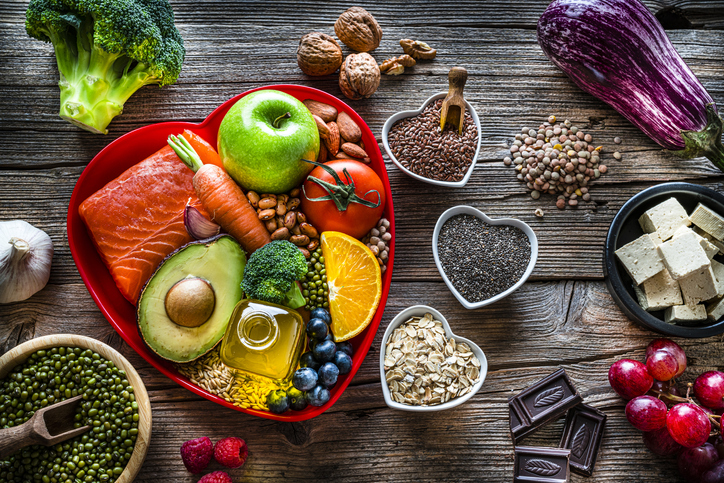How to Eat Healthier In today’s fast-paced world, maintaining a healthy diet can often be challenging. With tempting fast food options, busy schedules, and a myriad of conflicting diet advice, it’s easy to lose sight of what it means to eat healthily. However, choosing to prioritize your health through your diet is one of the most impactful decisions you can make. In this comprehensive guide, we will explore how you can eat more healthily, step by step.
Understanding the Basics of Nutrition

To embark on a journey toward healthier eating, it’s crucial to grasp the fundamentals of nutrition. Nutrition is the cornerstone of a healthy diet and plays a pivotal role in your overall well-being. By understanding the basics, you can make informed choices about what you eat and how it affects your body.
Nutrition can be broken down into two main categories: macronutrients and micronutrients.
Macronutrients: The Building Blocks of Nutrition
Macronutrients are the nutrients that your body requires in large quantities to function correctly. There are three primary macronutrients:
Carbohydrates: These are your body’s primary source of energy. Carbohydrates can be found in foods like grains, fruits, vegetables, and legumes. Opt for complex carbohydrates like whole grains for sustained energy.
Proteins: Proteins are essential for the growth, repair, and maintenance of tissues in your body. Good sources of protein include lean meats, fish, eggs, dairy products, legumes, and tofu.
Fats: Fats play a vital role in various bodily functions, including cell growth and hormone production. It’s important to differentiate between healthy fats found in avocados, nuts, and olive oil, and unhealthy fats found in processed foods.
Micronutrients: The Small but Mighty While you need macronutrients in larger quantities, micronutrients are equally important but are required in smaller amounts. Micronutrients include vitamins and minerals, and they are essential for various physiological processes in your body.
Vitamins are organic compounds that help regulate bodily functions. For example, vitamin C boosts your immune system, while vitamin D aids in calcium absorption for strong bones.
Minerals are inorganic substances that are vital for maintaining overall health. Minerals like calcium, potassium, and iron are essential for the proper functioning of your muscles, nerves, and red blood cells.
Understanding these basic principles of nutrition is the first step towards making healthier food choices. As you continue reading this guide, you’ll learn how to balance these nutrients in your diet effectively, incorporate more fruits and vegetables, choose whole grains, and embrace a variety of foods that will nourish your body and support your journey to better health.
Balancing Your Macronutrients
A crucial aspect of eating healthily is achieving the right balance of macronutrients in your diet. Macronutrients are the fundamental components of your food that provide energy and support various bodily functions. To optimize your nutrition, it’s important to understand and balance these macronutrients effectively.
Carbohydrates: Your Energy Source
Carbohydrates are your body’s primary source of energy. They are found in various foods, including grains, fruits, vegetables, and legumes. To strike the right balance:
Choose Complex Carbohydrates: Opt for complex carbohydrates found in whole grains like brown rice, quinoa, and whole wheat bread. These provide sustained energy and are rich in fibre, aiding in digestion.
Limit Simple Sugars: Minimize the consumption of simple sugars found in sugary snacks, sodas, and candies. They can lead to energy spikes and crashes.
Proteins: The Building Blocks
Proteins are essential for the growth, repair, and maintenance of tissues in your body. They are found in foods such as lean meats, fish, poultry, eggs, dairy products, legumes, and tofu. To balance protein intake:
Include Lean Sources: Choose lean sources of protein like skinless poultry, fish, and legumes. These options are lower in saturated fat.
Diversify Protein Sources: Incorporate a variety of protein sources into your diet to ensure you get a range of essential amino acids.
Fats: The Good and the Bad
Fats play a critical role in bodily functions, including hormone production and the absorption of fat-soluble vitamins. To balance fats:
Embrace Healthy Fats: Include sources of healthy fats in your diet such as avocados, nuts, seeds, and olive oil. These fats support heart health.
Limit Saturated and Trans Fats: Reduce consumption of saturated fats found in fried and processed foods. Avoid trans fats commonly found in some packaged snacks.
Balancing your macronutrients means choosing a variety of foods that provide a mix of carbohydrates, proteins, and fats. This balance ensures you have the energy you need while supporting your overall health. As you progress through this guide, you’ll discover how to incorporate more of these nutrients through your food choices and achieve a well-rounded, nutritious diet.
Incorporating Fruits and Vegetables
Adding More Fruits and Vegetables to Your Diet
One of the cornerstones of a healthy diet is incorporating ample fruits and vegetables. These natural wonders are packed with essential vitamins, minerals, fibre, and antioxidants, making them essential for your overall well-being. Here’s how to seamlessly include more of these nutritious foods into your daily meals:
Aim for a Rainbow of Colors
Fruits and vegetables come in an array of vibrant colours, each offering unique health benefits. To maximize the nutritional value of your diet:
Go Green: Leafy greens like spinach, kale, and broccoli are rich in vitamins A and C, as well as calcium and fibre. They are excellent for overall health and digestion.
Embrace Bright Berries: Berries like blueberries, strawberries, and raspberries are packed with antioxidants that combat free radicals, supporting heart and brain health.
Get Your Vitamin C: Citrus fruits like oranges, grapefruits, and lemons are renowned for their high vitamin C content, which boosts your immune system.
Orange and Yellow Power: Carrots, sweet potatoes, and squash are packed with beta-carotene, promoting good vision and immune function.
Red Richness: Tomatoes, red peppers, and watermelon contain lycopene, an antioxidant known for its potential cancer-fighting properties.
Make It Convenient
Incorporating fruits and vegetables into your diet can be easy and convenient:
Pre-cut and Pre-pack: Buy pre-cut vegetables and fruits to save time when preparing meals or snacks.
Frozen Options: Keep a stash of frozen fruits and vegetables in your freezer. They are just as nutritious as fresh ones and have a longer shelf life.
Smoothies: Blend fruits and leafy greens into smoothies for a delicious and nutrient-packed start to your day.
Experiment with Cooking Techniques
Cooking fruits and vegetables in various ways can enhance their flavours and textures:
Roasting: Roasting vegetables with a bit of olive oil and your favourite seasonings can bring out their natural sweetness.
Stir-frying: Quick stir-frying retains the crunch and colour of vegetables while infusing them with flavours.
Grilling: Grilled fruits like pineapple and peaches are a delightful and healthy dessert option.
Steaming: Steaming preserves the maximum nutrients in your veggies, making it an excellent cooking method.
Sneak Them In
Sometimes, it’s easy to sneak fruits and vegetables into dishes:
Add Greens to Your Sandwich: Layer lettuce, spinach, or arugula onto your sandwiches or wraps for extra crunch and nutrition.
Top Your Cereal: Sprinkle fresh berries or sliced bananas on your morning cereal or yoghurt.
Blend Veggies into Sauces: Puree vegetables like carrots or spinach and add them to pasta sauces or soups.
By incorporating a variety of colourful fruits and vegetables into your diet, you not only enhance the taste of your meals but also boost your overall health. These nutrient-rich foods are essential for providing your body with the vitamins, minerals, and antioxidants it needs to thrive.
Choosing Whole Grains
When it comes to improving your diet, choosing whole grains over refined grains is a significant step towards better health. Whole grains are packed with essential nutrients, fibre, and energy-sustaining carbohydrates. Here’s how you can make informed choices and incorporate whole grains into your daily meals:
What Are Whole Grains?
Whole grains are grains that have not been stripped of their bran and germ during processing. This means they retain their full nutritional value. Examples of whole grains include:
Brown Rice: Brown rice is a whole grain rich in fibre, vitamins, and minerals. It’s a great alternative to white rice.
Quinoa: Quinoa is a complete protein source and contains all nine essential amino acids, making it an excellent choice for vegetarians and vegans.
Whole Wheat: Whole wheat products, like whole wheat bread and pasta, retain the bran and germ, offering more nutrients than their refined counterparts.
Oats: Oats are high in fibre and provide sustained energy. They are a versatile addition to your diet, perfect for breakfast or baking.
Barley: Barley is a whole grain rich in fibre, vitamins, and minerals. It’s often used in soups and stews.
Why Choose Whole Grains?
Whole grains offer several health benefits:
Fibre-Rich: They are high in dietary fibre, which aids in digestion, helps maintain a healthy weight, and reduces the risk of chronic diseases.
Nutrient-Packed: Whole grains are a good source of essential nutrients, including B vitamins, iron, magnesium, and selenium.
Steady Energy: The complex carbohydrates in whole grains provide sustained energy, preventing energy crashes.
Heart Health: Consuming whole grains can reduce the risk of heart disease by lowering cholesterol levels and regulating blood pressure.
How to Incorporate Whole Grains
Here’s how you can easily include more whole grains in your diet:
Choose Whole Grain Varieties: When shopping, opt for whole-grain versions of bread, pasta, and cereal.
Experiment with New Grains: Try grains like quinoa, barley, farro, and bulgur in your recipes to add variety and nutrition.
Snack Smart: Enjoy whole-grain snacks like air-popped popcorn instead of chips or crackers made from refined grains.
Read Labels: Look for products that list a whole grain as the first ingredient. Beware of “multigrain” or “wheat” products, which may not be whole grain.
By choosing whole grains over refined grains, you’re taking a positive step towards better health and nutrition. These grains not only provide essential nutrients but also keep you feeling fuller for longer, making them an integral part of a balanced diet.
Lean Proteins: Your Body’s Building Blocks
Proteins are the building blocks of life, and incorporating lean sources of protein into your diet is essential for overall health and well-being. These valuable nutrients are responsible for tissue repair, muscle growth, and the proper functioning of various bodily systems. In this section, we’ll explore the significance of lean proteins and how to make smart choices to benefit your body.
What Are Lean Proteins?
Lean proteins are protein sources that are low in unhealthy fats while being rich in essential nutrients. These proteins provide all the necessary amino acids your body needs without the excess saturated fat commonly found in fatty cuts of meat. Some excellent sources of lean protein include:
Poultry: Skinless chicken and turkey are low in fat and provide a healthy dose of protein.
Fish: Fatty fish like salmon, trout, and mackerel offer heart-healthy omega-3 fatty acids in addition to protein.
Lean Cuts of Meat: If you prefer red meat, opt for lean cuts such as sirloin, tenderloin, or lean ground beef.
Plant-Based Proteins: Legumes, tofu, tempeh, and edamame are excellent sources of plant-based proteins, perfect for vegetarians and vegans.
The Importance of Lean Proteins
Lean proteins offer several key benefits:
Muscle Maintenance: Protein plays a crucial role in muscle growth and repair, making it essential for active individuals and athletes.
Satiety: Protein-rich foods help you feel full and satisfied, reducing the likelihood of overeating.
Metabolism Boost: Digesting protein requires more energy than digesting carbohydrates or fats, which can support weight management.
Nutrient Density: Lean proteins provide essential vitamins and minerals without the added calories and unhealthy fats found in fattier cuts of meat.
Incorporating Lean Proteins
Here’s how you can easily include more lean proteins in your diet:
Grilled or Baked: Choose cooking methods like grilling or baking to preserve the natural flavours of lean proteins.
Healthy Pairings: Pair lean proteins with vegetables, whole grains, and healthy fats for balanced and satisfying meals.
Plant-Based Alternatives: Explore plant-based proteins like tofu and legumes as alternatives to meat.
Healthy Snacks: Snack on protein-rich foods like Greek yoghurt, cottage cheese, or mixed nuts for a satisfying and nutritious pick-me-up.
Portion Control: While lean proteins are healthy, be mindful of portion sizes to maintain a balanced diet.
Incorporating lean proteins into your daily meals not only supports muscle health but also aids in weight management and overall well-being. By making smart protein choices, you can enjoy delicious and satisfying meals while prioritizing your health.
Healthy Fats: The Good Kind
Healthy Fats: Beneficial for Your Well-being
Fats are an essential part of a balanced diet, and when chosen wisely, they can contribute to your overall health. In this section, we’ll delve into the importance of healthy fats, where to find them, and how to incorporate them into your daily meals.
What Are Healthy Fats?
Healthy fats, often referred to as “good fats,” are unsaturated fats that offer a range of health benefits without the drawbacks associated with saturated and trans fats. There are two primary types of healthy fats:
Monounsaturated Fats: These fats are found in foods like avocados, nuts, and olive oil. They are known to promote heart health by lowering bad cholesterol levels.
Polyunsaturated Fats: Polyunsaturated fats include essential fatty acids like omega-3 and omega-6. They support brain function, reduce inflammation, and are found in sources such as fatty fish (salmon, mackerel), flaxseeds, walnuts, and soybean oil.
The Significance of Healthy Fats
Healthy fats offer a range of benefits for your well-being:
Heart Health: They can improve cardiovascular health by reducing bad cholesterol levels and decreasing the risk of heart disease.
Brain Function: Omega-3 fatty acids, a type of polyunsaturated fat, are vital for brain development and cognitive function, contributing to mental well-being.
Joint Health: Healthy fats may reduce inflammation, benefiting individuals with conditions like arthritis and other inflammatory disorders.
Absorption of Fat-Soluble Vitamins: Healthy fats play a role in the absorption of fat-soluble vitamins A, D, E, and K, supporting overall health.
Incorporating Healthy Fats
Here’s how you can easily introduce more healthy fats into your diet:
Cook with Olive Oil: Substitute butter or lard with olive oil for cooking and as a base for salad dressings.
Snack on Nuts: Enjoy a handful of almonds, walnuts, or pistachios as a satisfying and heart-healthy snack.
Fatty Fish: Incorporate fatty fish like salmon, mackerel, and sardines into your diet at least twice a week to reap the benefits of omega-3 fatty acids.
Avocado: Add slices of creamy avocado to sandwiches, and salads, or use it as a topping for your morning toast.
Chia and Flaxseeds: Sprinkle chia or flaxseeds on yogurt, and oatmeal, or blend them into smoothies for a boost of omega-3 fatty acids.
Limit Saturated and Trans Fats: Reduce your intake of saturated fats commonly found in red meat and processed foods, as well as trans fats found in some fried and packaged snacks.
By integrating healthy fats into your daily meals, you not only enhance the flavour and texture of your food but also support heart health, brain function, and overall well-being. Making mindful choices about the types of fats you consume can contribute to a healthier lifestyle.
Hydration: The Forgotten Essential
Hydration: Often Overlooked, Always Essential
While it’s easy to focus on what foods to eat, the importance of proper hydration is frequently underestimated. Staying well-hydrated is a fundamental aspect of maintaining your health and well-being. In this section, we’ll explore why hydration is essential, how much water you need, and practical ways to ensure you stay adequately hydrated.
Why is Hydration Important?
Proper hydration is vital for several key reasons:
Cell Function: Water is essential for cellular functions and maintaining electrolyte balance, ensuring that your cells can perform their roles efficiently.
Temperature Regulation: Adequate hydration helps regulate your body temperature, preventing overheating during physical activity or in hot weather.
Digestion: Water aids in the digestion and absorption of nutrients, helping your body extract essential elements from the food you eat.
Detoxification: Hydration supports your body’s natural detoxification processes by helping to flush out waste and toxins.
Joint Health: Proper hydration lubricates joints, reducing the risk of stiffness and injury.
How Much Water Do You Need?
The amount of water you need can vary based on factors such as your age, activity level, and climate. However, a general guideline is to aim for about 8 to 10 cups (64 to 80 ounces) of water per day for most adults. This includes water from beverages and food.
You may need more if you:
Engage in vigorous physical activity.
Live in a hot or humid climate.
Are pregnant or breastfeeding?
Have certain medical conditions, like kidney stones.
Staying Hydrated
Here are some practical ways to ensure you stay well-hydrated:
Drink Water Throughout the Day: Sip water regularly rather than trying to consume large amounts at once.
Monitor Your Urine: Check the colour of your urine; it should be pale yellow. Dark yellow or amber urine may indicate dehydration.
Include Hydrating Foods: Consume foods with high water content, like fruits (e.g., watermelon, oranges) and vegetables (e.g., cucumber, celery).
Set Reminders: Use phone apps or alarms to remind you to drink water, especially if you tend to forget.
Carry a Reusable Water Bottle: Having a water bottle with you makes it easy to take sips throughout the day.
Hydrate Before and After Exercise: Drink water before, during, and after physical activity to replenish lost fluids.
Avoid Excess Caffeine and Alcohol: These substances can have a diuretic effect, potentially increasing fluid loss.
Signs of Dehydration
Recognizing the signs of dehydration is crucial:
Thirst is an obvious indicator.
Dry mouth and dry skin.
Dark yellow urine.
Fatigue or dizziness.
Headache.
Rapid heartbeat or rapid breathing.
If you experience any of these symptoms, it’s essential to increase your fluid intake promptly.
Proper hydration is a simple yet powerful way to support your overall health and well-being. By making it a habit to drink enough water throughout the day, you can ensure that your body functions optimally and stays energized.
Mindful Eating: Savor Every Bite
Mindful Eating: Embrace the Pleasure of Every Bite
In today’s fast-paced world, meals are often rushed, and the true joy of eating can be lost in the whirlwind of daily life. Mindful eating is a practice that encourages you to savour and appreciate each bite, promoting a healthier relationship with food and enhancing your overall well-being. In this section, we’ll explore what mindful eating is, its benefits, and how to incorporate it into your daily routine.
What Is Mindful Eating?
Mindful eating is a practice rooted in mindfulness, a concept that involves being fully present in the moment and paying deliberate attention to your experiences without judgment. When applied to eating, it means being fully engaged with your food and the act of eating, rather than consuming meals on autopilot.
The Benefits of Mindful Eating
Practising mindful eating can have numerous positive effects on your physical and mental well-being:
Better Digestion: When you eat slowly and savour each bite, it aids in proper digestion, reducing the likelihood of digestive discomfort.
Weight Management: Mindful eating can help you recognize genuine hunger cues and prevent overeating, contributing to weight control.
Enhanced Enjoyment: You’ll discover a heightened appreciation for the flavours and textures of your food, leading to a more pleasurable eating experience.
Reduced Stress: Mindful eating can reduce stress and emotional eating by fostering a more conscious and thoughtful relationship with food.
Improved Body Awareness: It helps you become more attuned to your body’s hunger and fullness signals, allowing you to respond appropriately.
How to Practice Mindful Eating
Incorporating mindful eating into your life can be straightforward with these steps:
Pause and Breathe: Before you start eating, take a moment to pause and take a few deep breaths. This centres on you and brings your attention to the present moment.
Eat Slowly: Consume your meal at a leisurely pace, savouring each bite. Put down your utensils between bites to slow down the process.
Engage Your Senses: Pay attention to the colours, textures, and aromas of your food. Appreciate the complexity of flavours in each mouthful.
Chew Thoroughly: Chew your food well; this not only aids in digestion but also allows you to fully experience the taste and texture of what you’re eating.
Listen to Your Body: Tune in to your body’s hunger and fullness cues. Eat until you’re satisfied, not overly full.
Minimize Distractions: Try to eat without distractions such as television, smartphones, or work. Focus solely on your meal.
Express Gratitude: Take a moment to express gratitude for your food and those involved in its production, recognizing the effort that went into bringing it to your table.
By practising mindful eating, you can transform your relationship with food into one of appreciation, nourishment, and fulfilment. This approach to eating encourages you to savour every bite, leading to a deeper connection with your meals and ultimately supporting your overall well-being.
The Importance of Portion Control
Portion Control: A Key to a Balanced Diet
Maintaining a healthy diet isn’t just about what you eat; it’s also about how much you eat. Portion control plays a pivotal role in ensuring that you consume the right amount of food to meet your nutritional needs while preventing overeating. In this section, we’ll delve into why portion control is essential, how to practice it, and the benefits it brings to your overall health.
Why is Portion Control Important?
Portion control is crucial for several reasons:
Caloric Balance: Controlling portion sizes helps you manage your calorie intake, which is vital for maintaining a healthy weight. Consuming too many calories can lead to weight gain and related health issues.
Nutrient Balance: Proper portions ensure that you get a balanced mix of essential nutrients, including carbohydrates, proteins, fats, vitamins, and minerals.
Blood Sugar Management: Portion control can help regulate blood sugar levels, especially important for individuals with diabetes or those at risk of developing it.
Digestive Health: Overeating can strain your digestive system, leading to discomfort. Appropriate portions support smoother digestion.
Long-Term Health: Consistently practising portion control can contribute to better long-term health by preventing chronic diseases like obesity, heart disease, and diabetes.
How to Practice Portion Control
Here are practical ways to implement portion control in your daily life:
Use Measuring Tools: Invest in measuring cups and a kitchen scale to accurately portion your food.
Read Labels: Pay attention to serving sizes on food labels. They guide appropriate portions.
Divide Restaurant Meals: When dining out, consider sharing an entree or immediately requesting a to-go box to split the meal.
Mindful Eating: Pay close attention to your body’s hunger and fullness cues. Stop eating when you feel satisfied, not overly full.
Use Smaller Plates: Smaller plates and bowls can trick your brain into thinking you’re consuming larger portions.
Plan Ahead: Prepare meals and snacks in advance, pre-portioning them into containers. This can prevent impulsive overeating.
Avoid Eating Straight from Packages: Pour snacks into a bowl rather than eating directly from the bag, which can lead to mindless overeating.
Eat Slowly: Take your time to savour each bite. Eating slowly allows your body to register fullness more accurately.
The Benefits of Portion Control
Practicing portion control offers numerous benefits:
Weight Management: It helps control calorie intake, supporting weight loss or maintenance goals.
Blood Sugar Control: Portion control can help stabilize blood sugar levels, reducing the risk of diabetes and managing the condition for those already diagnosed.
Digestive Comfort: Proper portion sizes promote better digestion, reducing discomfort.
Improved Nutrient Intake: It ensures you get a variety of nutrients without excessive calorie consumption.
Psychological Satisfaction: You can enjoy a sense of satisfaction from finishing a well-portioned meal without overindulging.
Incorporating portion control into your eating habits empowers you to make conscious choices about what and how much you eat. This practice not only supports your short-term goals but also contributes to better long-term health and well-being.
Healthy Cooking Methods
Healthy Cooking Methods: Nourishing Your Body with Every Bite
The way you prepare your food has a significant impact on its nutritional value. Healthy cooking methods not only enhance the flavour of your meals but also help preserve the essential nutrients within the ingredients. In this section, we’ll explore some of the healthiest cooking methods and their benefits.
1. Grilling
Grilling is a popular and healthy cooking method that involves cooking food over an open flame or on a grill grate. It’s an excellent choice for:
Lean Proteins: Grilling chicken, fish, or lean cuts of meat allows excess fat to drip away, resulting in lower calorie content.
Vegetables: Grilled vegetables like peppers, zucchini, and eggplant develop a smoky flavour and retain their vitamins and minerals.
To make grilling even healthier, marinate proteins in herbs and spices to reduce the formation of harmful compounds.
2. Steaming
Steaming is a gentle cooking method that involves using steam to cook food. It’s ideal for:
Preserving Nutrients: Steaming minimizes nutrient loss, making it an excellent choice for vegetables like broccoli, spinach, and carrots.
Fish: Steaming fish keeps it moist while preserving its delicate flavour.
Steaming is simple and requires minimal equipment, such as a steaming basket or microwave-safe container with a lid.
3. Baking and Roasting
Baking and roasting involve cooking food in an oven, often without added fats. These methods are great for:
Whole Grains: Baking is perfect for whole grains like brown rice and quinoa, ensuring they cook evenly.
Root Vegetables: Roasting root vegetables like sweet potatoes and beets bring out their natural sweetness without added oils.
To keep these methods healthy, use non-stick cooking spray or parchment paper to reduce the need for excessive fats.
4. Stir-Frying
Stir-frying involves quickly cooking small pieces of food in a hot pan with a minimal amount of oil. It’s ideal for:
Vegetables: Stir-frying retains the vibrant colours and crunch of vegetables while preserving their nutrients.
Lean Proteins: Cooking lean proteins like tofu or skinless chicken in a stir-fry adds protein without excessive fat.
To maintain the health benefits, use a high-quality non-stick pan and opt for oils with a high smoke point like canola or peanut oil.
5. Poaching
Poaching involves gently simmering food in a flavoured liquid, often water or broth. It’s excellent for:
Chicken and Fish: Poaching keeps these proteins tender and moist while imparting subtle flavours.
Fruits: Poaching fruits like pears or apples in a lightly sweetened liquid makes for a healthy dessert.
Poaching is a low-fat method that retains the natural flavours of the ingredients.
6. Microwaving
Microwaving is a quick and efficient way to cook or heat food. It’s a suitable choice for:
Steaming Vegetables: Place a small amount of water and vegetables in a microwave-safe dish, cover, and microwave for a few minutes for perfectly steamed veggies.
Reheating Leftovers: Microwaving leftovers is a convenient way to enjoy a hot meal while retaining their nutritional value.
Microwaving with minimal liquid helps preserve nutrients.
7. Boiling
Boiling involves cooking food in boiling water. It’s ideal for:
Pasta and Whole Grains: Boiling ensures even cooking and provides a neutral base for various dishes.
Eggs: Boiling eggs is a simple way to prepare a protein-rich snack or ingredient.
To minimize nutrient loss, use as little water as possible and avoid overcooking.
Choosing the right cooking method can make your meals not only delicious but also nutritious. By incorporating these healthy cooking techniques into your culinary repertoire, you can enjoy meals that are both satisfying and good for your well-being
Snacking Wisely
Snacking Wisely: Nourishing Your Body Between Meals
Snacking can be a valuable part of your daily diet when approached mindfully. Making smart snacking choices can help maintain your energy levels, curb hunger between meals, and provide essential nutrients. In this section, we’ll explore the art of snacking wisely, including what to eat and when to reach for a snack.
The Importance of Smart Snacking
When done thoughtfully, snacking offers several benefits:
Sustained Energy: A nutritious snack can keep your energy levels stable throughout the day, preventing energy slumps.
Hunger Management: Smart snacking can help control excessive hunger, reducing the temptation to overeat during main meals.
Nutrient Boost: Snacks can be an opportunity to incorporate essential vitamins, minerals, and fibre into your diet.
Mindful Eating: Snacking with intention allows you to appreciate food mindfully, savouring its flavours and textures.
What Makes a Healthy Snack?
Healthy snacks should provide a balanced combination of macronutrients (carbohydrates, protein, and healthy fats) and ideally include:
Fruits and Vegetables: Fresh produce like apple slices, carrot sticks, or cherry tomatoes provides essential vitamins and fibre.
Protein: Protein-rich options like Greek yoghurt, cottage cheese, or lean turkey slices can help keep you satiated.
Whole Grains: Whole-grain crackers, rice cakes, or whole-grain bread can offer lasting energy.
Healthy Fats: Nuts, seeds, and avocado slices are sources of healthy fats that can keep you feeling full.
When to Snack Wisely
Timing plays a vital role in smart snacking:
Between Meals: Consider having a snack if you feel genuinely hungry between regular meal times, typically mid-morning or mid-afternoon.
Pre-Workout: Eating a small, balanced snack before exercise can provide the necessary energy and improve your performance.
Post-Workout: After a workout, a snack with protein and carbohydrates can aid in recovery.
Late Evening: If dinner is early, a light and nutritious snack can prevent late-night overindulgence.
Tips for Smart Snacking
Here are some guidelines to help you make wise snacking choices:
Portion Control: Avoid mindlessly munching from a large bag or container. Portion your snacks into smaller bowls or containers.
Plan Ahead: Prepare healthy snacks in advance, making them easily accessible when hunger strikes.
Stay Hydrated: Sometimes, thirst is mistaken for hunger. Drink a glass of water before reaching for a snack.
Read Labels: Pay attention to ingredient lists and nutritional information, avoiding snacks high in added sugars and unhealthy fats.
Listen to Your Body: Snack when you’re genuinely hungry, not out of habit or boredom.
Combine Food Groups: Pair a carbohydrate with a source of protein or healthy fats for a satisfying and balanced snack.
By snacking wisely, you can support your overall health and well-being. Thoughtful snacking choices provide an opportunity to nourish your body, maintain energy levels, and practice mindful eating habits.
Eating Out Healthily
Dining Out Healthily: Making Nutritious Choices at Restaurants
Eating out at restaurants doesn’t have to derail your healthy eating habits. With some thoughtful planning and smart choices, you can enjoy a delicious meal while still prioritizing your well-being. In this section, we’ll explore how to make nutritious choices when dining out.
Choose the Right Restaurant
Opting for a restaurant with a variety of healthy options is the first step:
Look for Menu Variety: Seek out restaurants that offer a range of dishes, including salads, lean proteins, and whole grains.
Check Online Menus: Many restaurants now provide their menus online, allowing you to review choices before arriving.
Read Reviews: Online reviews often mention healthy or lighter menu items, helping you make an informed decision.
Navigate the Menu Wisely
Once you’re at the restaurant, consider these strategies:
Start with Salad: Begin your meal with a salad rich in vegetables, but go easy on high-calorie dressings and toppings.
Choose Lean Proteins: Opt for grilled, baked, or steamed lean proteins like chicken, fish, or tofu instead of fried or heavily sauced options.
Control Portions: Many restaurant portions are larger than necessary. Consider sharing a dish with a friend or asking for a to-go box upfront to save half for later.
Mind Your Sides: Swap out calorie-laden sides like fries for healthier options such as steamed vegetables or a side salad.
Watch for Hidden Calories: Be aware of items cooked with heavy creams, butter, or excessive oil, which can add unwanted calories.
Be Mindful of Beverages
Your choice of beverages can also impact the overall healthiness of your meal:
Water: Opt for water, sparkling water, or unsweetened iced tea to keep calorie intake in check.
Limit Sugary Drinks: Avoid sugary sodas, fruit juices, and excessive alcohol, which can add empty calories.
Moderate Alcohol: If you choose to drink alcohol, do so in moderation to limit calorie intake and potential impairment.
Practice Portion Control
Restaurants often serve larger portions than you need. To manage portions effectively:
Share with a Friend: Split an entree with a dining companion to reduce calorie intake.
Ask for a Half-Portion: Some restaurants offer smaller portion options or allow you to order a half-portion of a dish.
Take Leftovers: If you receive a sizable portion, immediately set aside half for another meal.
Be Mindful of Extras
Lastly, pay attention to additional factors that can influence your choices:
Bread Baskets: Limit bread consumption before your meal, as it can add unnecessary calories.
Condiments: Use condiments, sauces, and dressings sparingly to control calorie intake.
Dessert: If you’re craving dessert, consider sharing or choosing a lighter option like fruit or sorbet.
By making informed choices and practising moderation when dining out, you can enjoy restaurant meals without compromising your commitment to a healthy lifestyle.
Staying Consistent and Overcoming Challenges
Maintaining Consistency and Conquering Obstacles on Your Wellness Journey
Achieving and sustaining a healthy lifestyle is a commendable goal, but it often comes with challenges along the way. Staying consistent and overcoming these obstacles is key to long-term success. In this section, we’ll explore strategies for maintaining your commitment to well-being and conquering common challenges.
The Importance of Consistency
Consistency is the foundation of a healthy lifestyle. It ensures that healthy habits become ingrained in your daily routine and lead to lasting change. Here’s how to stay on track:
- Set Realistic Goals: Start with achievable goals that fit your life. Gradual progress is more sustainable than sudden, drastic changes.
- Create a Routine: Establish a daily or weekly routine that includes exercise, meal planning, and self-care practices.
- Track Your Progress: Keep a journal or use a fitness app to monitor your progress. Seeing your achievements can be motivating.
- Stay Accountable: Share your goals with a friend, family member, or fitness buddy who can hold you accountable.
Overcoming Common Challenges
Recognize that challenges are a natural part of any wellness journey. Here’s how to tackle some common obstacles:
- Time Constraints: A busy schedule is a frequent challenge. Prioritize your health by scheduling workouts and meal prep like you would any other appointment.
- Cravings and Temptations: Cravings for unhealthy foods can be tough. Plan for occasional indulgences and have healthier alternatives readily available.
- Plateaus: It’s common to hit fitness or weight loss plateaus. Adjust your workouts and dietary choices to overcome these stalls.
- Lack of Motivation: Motivation can wane over time. Change up your routine, set new goals, or seek inspiration from fitness communities or role models.
- Stress: Stress can derail your efforts. Incorporate stress-reduction practices like meditation, yoga, or deep breathing into your routine.
Celebrate Small Wins
Don’t underestimate the power of celebrating small victories along the way:
- Acknowledge Progress: Celebrate reaching milestones, whether it’s losing a few pounds, running an extra mile, or making healthier food choices.
- Reward Yourself: Treat yourself to non-food rewards like a spa day, a new fitness accessory, or a movie night as you achieve your goals.
- Positive Self-Talk: Replace self-criticism with self-encouragement. Recognize and appreciate your efforts, no matter how small they may seem.
Seek Support
You don’t have to navigate your wellness journey alone:
- Join a Community: Connect with like-minded individuals through fitness classes, support groups, or online forums for encouragement and shared experiences.
- Professional Guidance: Consider consulting a registered dietitian, personal trainer, or therapist to address specific challenges.
Adapt and Stay Flexible
Remember that your journey to well-being is not a straight line. It may involve detours and setbacks, but the key is to adapt and stay flexible:
- Learn from Setbacks: Instead of viewing setbacks as failures, see them as opportunities to learn and grow.
- Adjust Your Approach: If a particular strategy isn’t working, be open to trying new methods until you find what works best for you.
Consistency and resilience are your allies on the path to a healthier lifestyle. By setting realistic goals, tackling challenges head-on, celebrating your achievements, seeking support, and staying flexible, you can maintain your commitment to well-being and enjoy the long-term benefits of a healthier, happier you.
Conclusion
Embracing a Healthier You
Embarking on a journey to a healthier lifestyle is a commendable and transformative choice. Throughout this comprehensive guide, we’ve explored various facets of well-being, from nutrition and exercise to mindfulness and overcoming challenges. Now, as we conclude, let’s recap some key takeaways to help you embrace a healthier you:
Nutrition Matters: A balanced diet rich in whole foods, lean proteins, fruits, vegetables, and healthy fats is the foundation of good health. Make informed choices about what you eat, emphasizing nutrient-dense options.
Stay Hydrated: Proper hydration is often overlooked but is essential for overall well-being. Drinking enough water supports digestion, energy levels, and overall vitality.
Mindful Eating: Savor each bite, pay attention to your body’s hunger cues, and eat with intention. Mindful eating enhances your relationship with food and promotes healthier choices.
Portion Control: Be mindful of portion sizes to manage calorie intake effectively. Controlling portions helps prevent overeating and supports weight management.
Healthy Cooking Methods: How you prepare your food matters. Opt for healthier cooking methods like grilling, steaming, baking, and stir-frying to retain nutrients while minimizing unnecessary fats.
Snack Wisely: Snacking can be a valuable part of your diet when approached thoughtfully. Choose balanced snacks with a combination of micronutrients, and pay attention to timing and portion sizes.
Eating Out Smartly: You can enjoy restaurant meals while making nutritious choices. Look for restaurants with diverse menu options, navigate menus wisely, and practice moderation.
Consistency Is Key: Consistency is essential for long-term success. Set realistic goals, establish routines, and stay accountable to maintain a healthy lifestyle.
Overcoming Challenges: Challenges are a natural part of your wellness journey. Identify common obstacles and implement strategies to conquer them. Seek support from communities and professionals when needed.
Celebrate Progress: Acknowledge and celebrate your achievements, no matter how small they may seem. Positive reinforcement can boost motivation and self-esteem.
Stay Flexible: Adapt and adjust your approach as needed. Your wellness journey may involve detours and setbacks, but flexibility and resilience will keep you on track.
Remember that your journey to a healthier you is a personal and ongoing process. Embrace it with patience, self-compassion, and a commitment to your well-being. By implementing these principles and staying dedicated to your health, you’re on a path to a life filled with vitality and fulfilment.















